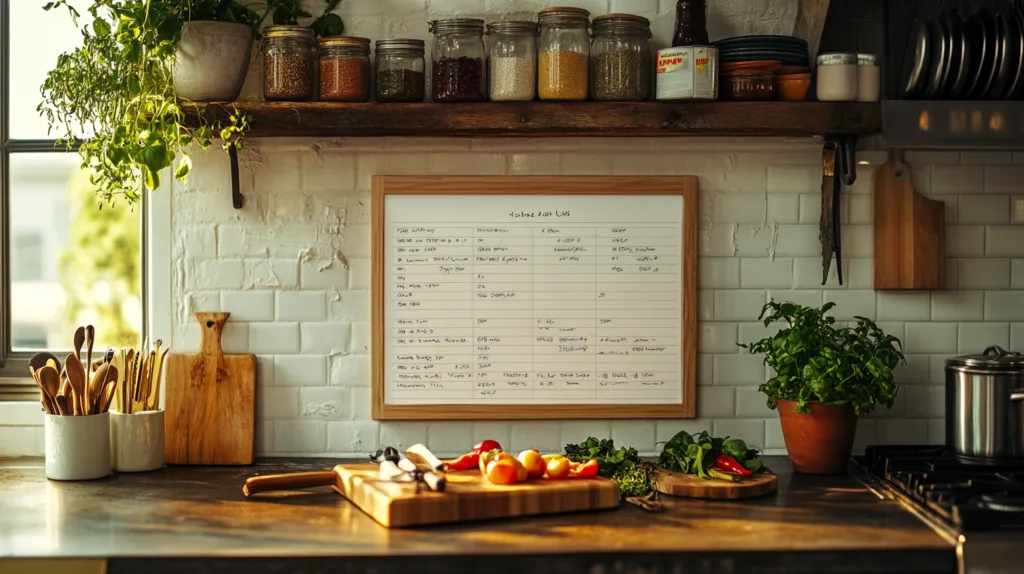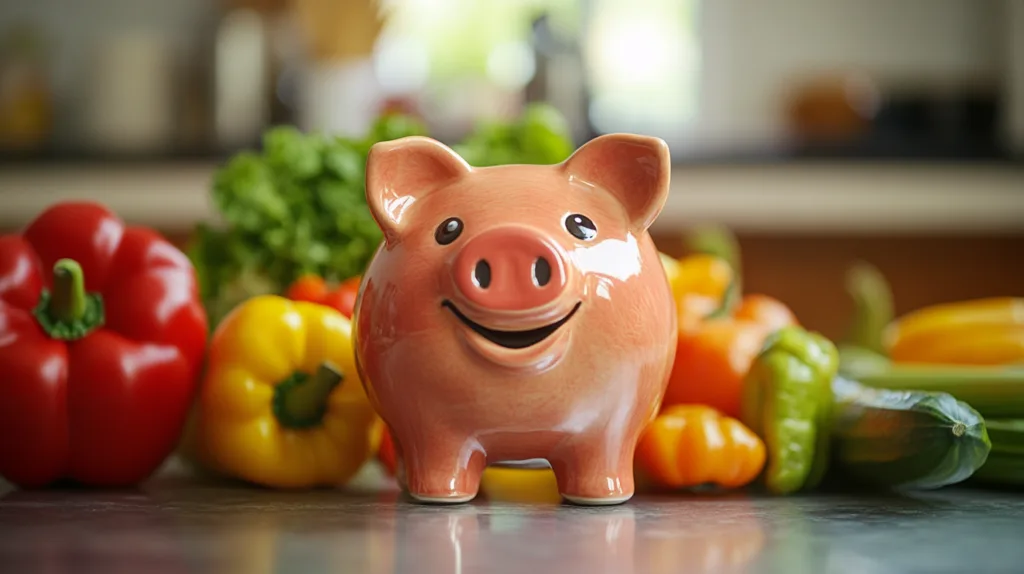Understanding Meal Planning
Definition of Meal Planning
Let’s dive into meal planning 101! Meal planning is the process of organizing your meals ahead of time, typically for a week. This means you’ll select recipes, create a grocery list, and sometimes prep ingredients before the week begins. I love how meal planning takes the guesswork out of dinnertime! Instead of scrambling to figure out what to cook after a long day, I can simply look at my plan. This not only saves time but also makes it easier to whip up nutritious meals that my family will enjoy. Meal planning can vary in complexity, from jotting down a few meal ideas to creating detailed plans that specify every meal and even portion sizes.
Benefits of Meal Planning

Planning my meals has transformed how I approach cooking and eating. Here are some benefits I’ve experienced:
- Saving Time: When you know what you’re going to eat, shopping and cooking become quicker and less stressful.
- Saving Money: By sticking to a grocery list based on your meals, you can avoid impulse buys and reduce food waste.
- Improving Nutrition: Meal planning helps ensure a balanced diet with plenty of fruits, vegetables, and whole grains.
- Achieving Goals: If you have specific dietary goals, planning meals helps you stick to your targets, such as losing weight or maintaining energy for workouts.
Overall, meal planning opens up a world of possibilities while cutting down on stress, making it a win-win for any busy lifestyle!
Getting Started with Meal Planning
Assessing Your Current Eating Habits
Now that we understand what meal planning is and its benefits, let’s get started! The first step in your meal planning journey is assessing your current eating habits. This means taking a closer look at what you typically eat each week. Start by asking yourself:
- What meals do I enjoy?
- Are there any foods I tend to avoid?
- How often do I eat out or order in?
By keeping a food diary for a week, you can track your meals and snacks. This helped me realize I relied too much on takeout after long workdays. Now, I make conscious choices to swap those meals for healthier, homemade options.
Setting Realistic Goals
Once you’ve assessed your eating habits, it’s time to set some realistic goals. Think about what you want to achieve:
- Do you want to eat healthier?
- Are you trying to lose or gain weight?
- Is your goal to save money on groceries?
Setting specific, achievable goals makes meal planning much easier. When I started, I aimed to cook three meals at home each week. Over time, that goal grew to planning meals for the whole week! Remember, it’s all about progress, not perfection. Setting goals that fit your lifestyle allows you to enjoy cooking and eating better. With this foundation in place, you’re ready to move on to the exciting part—planning your meals!
Meal Planning Tools and Resources
Kitchen Essentials for Meal Prep
Now that you’ve crafted your meal plan, it’s time to talk about the kitchen essentials that will make the prep and cooking process easier. Having the right tools can make all the difference! Here are some must-haves:
- Cutting Boards: A sturdy cutting board for chopping vegetables and meats is essential. Consider having a separate board for raw proteins.
- Knives: A good chef’s knife can speed up the prep process immensely. I personally can’t cook without mine!
- Food Storage Containers: These are vital for storing prepped ingredients and leftovers. I recommend glass containers with airtight lids to keep food fresh.
- Measuring Cups and Spoons: Accurate measurements are key in meal prep!
- Slow Cooker or Instant Pot: These appliances save time and effort, cooking meals while you focus on other tasks.
With these essentials, you’ll be set up for a smooth cooking experience.
Meal Planning Apps and Websites to Use
Technology can be a great ally when meal planning. There are a variety of apps and websites that help simplify the process.
- Stashcook: This app lets you save recipes, create meal plans, and generate grocery lists all in one place! It’s my go-to for staying organized.
- Pinterest: A treasure trove for inspiration, Pinterest is perfect for exploring new recipes and meal prep tips.
- Meal prep blogs: Sites like “Budget Bytes” and “RecipeTin Eats” offer fantastic recipes tailored for meal prep.
Using these tools and resources, you’ll find that planning and preparing meals becomes a fun and creative process! Plus, you’ll save both time and money along the way.
Creating a Meal Plan

Building a Balanced Plate
Now that you’ve gathered your tools and know the essentials of meal planning, let’s dive into the fun part: creating your meal plan! One of the first things to think about is building a balanced plate. When I first started meal planning, I realized that having a balanced meal made a huge difference in how I felt throughout the day. Here’s how I break it down:
- Protein: Aim for a serving of protein, like chicken, fish, beans, or tofu. This keeps you full and satisfied!
- Vegetables: Try to fill half your plate with vegetables and plan ahead to include a variety of colors and textures. I love mixing colorful options like bell peppers, broccoli, and carrots in my dishes.
- Whole Grains: Incorporate whole grains like brown rice, quinoa, or whole wheat pasta to provide energy.
- Healthy Fats: Don’t forget healthy fats from sources like olive oil, avocado, or nuts for added flavor and health benefits.
Balancing your plate not only promotes better nutrition but also adds variety to your meals, making them more enjoyable!
Tips for Ingredient Prep and Storage
Ingredient prep is where the magic happens! Effective prep can save you time and stress during the week. Here are some tips I’ve picked up over the years:
- Pre-chop Vegetables: Wash and chop your veggies right after grocery shopping. Store them in airtight containers, and they’ll be salad-ready throughout the week.
- Batch Cook Staples: Prepare big batches of grains and proteins. I often cook a large pot of quinoa that lasts several days. It’s perfect for quick salads and stir-fries!
- Label Your Containers: If you freeze meals, label them with the recipe name and date. This makes it easier to choose what to eat later without guessing.
- Store Properly: Use clear containers so you can see what you have at a glance. It’s less likely you’ll forget about leftovers!
By focusing on these strategies, you’ll smooth out the cooking process and ensure you enjoy healthy meals all week long!
Shopping and Budgeting for Meals

Strategies for Grocery Shopping
With your meal plan in hand, it’s time to tackle the grocery store! Effective shopping is crucial to sticking to your budget while getting all the ingredients you need. Here are some strategies that have worked for me:
- Stick to the List: Before heading to the store, make a detailed shopping list based on your meal plan. This helps avoid impulse buys that can quickly add up.
- Shop Once a Week: Time management is key! I usually shop once a week to save both time and money. Multiple trips can lead to more unnecessary purchases.
- Shop the Perimeter: The outer aisles of the grocery store often have fresher items like fruits, vegetables, and proteins. I tend to focus my shopping here before venturing into the inner aisles.
Budget-Friendly Meal Planning Tips
Sticking to a budget while meal planning can feel challenging, but it’s totally doable! Here are some of my favorite budget-friendly tips:
- Plan Around Sales: Check local grocery ads for sales on proteins or seasonal produce. I often plan my meals around what’s on special.
- Incorporate Meatless Meals: A couple of meat-free meals a week can significantly cut costs. I love making lentil soups or veggie stir-fries; they’re filling and affordable!
- Buy in Bulk: Items like grains, beans, and frozen vegetables are usually cheaper when bought in bulk. It not only saves money, but I can make larger batches for meal prep!
By combining these shopping strategies with budget-friendly tips, you’ll be on your way to enjoying delicious meals without breaking the bank!
Meal Prep and Cooking Techniques

Batch Cooking for Efficiency
Now that you have your meal plan in place, let’s talk about techniques to simplify your cooking! Batch cooking has been a game-changer for me, allowing for efficiency without compromising on flavor. It involves preparing larger quantities of meals at once, so you have ready-to-eat options throughout the week. Here’s how I do it:
- Choose Flexible Recipes: Dishes that store well and can be repurposed are ideal. Think hearty stews, chili, or casseroles that can be made in advance and stored in the fridge.
- Cook in Batches: I often prepare a large pot of quinoa or a tray of roasted vegetables that I can use in different meals throughout the week, making it easy to eat healthy. This way, I mix and match throughout the week.
- Portion Control: After cooking, I portion out meals into individual containers. This makes grab-and-go lunches super easy! Plus, having leftovers means less time in the kitchen later.
Healthy Cooking Methods to Try
When it comes to healthy cooking, the methods you use can significantly impact the nutritional content of your meals. Here are some techniques I love to incorporate:
- Steaming: This method retains nutrients in vegetables better than boiling. I steam broccoli or carrots to keep them vibrant and tasty.
- Grilling: Not only does it add a delicious smoky flavor, but grilling meats and veggies promotes using less oil.
- Roasting: Roasting enhances the natural sweetness of veggies. I love tossing my favorites with a bit of olive oil and seasoning for a satisfying side dish.
- Slow Cooking: This is great for tenderizing meats and infusing flavors. My slow cooker has become my best friend for easy weeknight meals!
By using these meal prep techniques and healthy cooking methods, you’ll find yourself enjoying nutritious meals with ease throughout the week!
Making Meal Planning a Habit
Time-Saving Tips for Busy Schedules
As you dive deeper into meal planning, making it a habit can transform your daily routine! With a busy schedule, it’s important to incorporate time-saving strategies that help you stick to it. Here are some tips that have worked wonders for me:
- Plan on a Consistent Day: I dedicate Sundays to plan and prep my meals for the week. Having a set day helps me stay organized and keeps me accountable.
- Utilize Freezer-Friendly Recipes: Prepare meals that freeze well, like soups or casseroles, so I can double batch and have options ready for weeks when I’m particularly busy.
- Designate a Prep Day: If your schedule allows it, set aside a few hours once a week for chopping, marinating, and cooking staples, so you’re not rushed during the week.
Meal Planning for Different Dietary Needs
It’s essential to tailor your meal planning to meet specific dietary needs, whether it’s for you or your family. Here are some ways to address dietary preferences:
- Be Mindful of Allergies: If someone is gluten or dairy intolerant, clearly note those restrictions while planning. I always have a few gluten-free meal options on standby.
- Adjust Portion Sizes: For families, consider the varying appetites. I often prepare larger portions for my husband, while keeping mine lighter and healthier.
- Include Variety: Incorporate several protein sources and plenty of vegetables to cater to different tastes and preferences. It makes meal planning more exciting!
By adopting these time-saving strategies and being mindful of dietary needs, you’ll form a sustainable meal planning habit that benefits everyone involved and helps you eat healthy!
Troubleshooting Common Meal Planning Challenges
Overcoming Recipe Burnout
As you continue your meal planning journey, it’s easy to fall into the trap of recipe burnout. I’ve been there too; after a few weeks of the same dishes, even my favorites can start to feel stale. To keep things fresh and exciting, here are some strategies that have worked for me:
- Rotate Recipes: I like to create a roster of go-to recipes for each meal type. Instead of making the same dinner every week, I’ll rotate through the favorites every few weeks.
- Explore New Flavors: Trying out new cuisines or ingredients can revitalize your meals and make planning your meals more enjoyable. For example, if I’ve been making Italian pasta dishes, I might switch to Thai curry or Mexican tacos for a change.
- Join Online Communities: Following meal planning groups or forums can provide inspiration and new ideas. I often browse Pinterest or Instagram for fresh recipes and cooking hacks.
Adapting Meal Plans for Unexpected Changes
Life is unpredictable, and your meal plans may need to be adjusted on the fly. This has happened to me when unexpected events pop up, whether it’s a last-minute dinner out or a busy day at work. Here’s how to handle it smoothly:
- Keep Backup Meals: I always prepare a few extra individual-sized servings of meals that freeze well. Having a healthy option readily available can save the day when plans change.
- Stay Flexible: If I have to switch meals around, I simply look at my ingredients for the week and make adjustments. For instance, if I’m suddenly eating out on a planned cooking night, I’ll save the cooked protein for later in the week.
- Embrace Leftovers: Use leftovers creatively! I often repurpose leftover proteins into different dishes, like turning grilled chicken from one night into a stir-fry or salad on another.
By incorporating these ideas, you can tackle recipe fatigue and adaptability with ease, keeping your meal planning both enjoyable and flexible!
Sustainability and Meal Planning
Minimizing Food Waste
As we wrap up our meal planning journey, it’s essential to consider the broader impact of our choices. One major benefit of meal planning is its ability to help us minimize food waste and stay within our food budget. I can’t tell you how many times I’ve tossed out wilted greens or forgotten leftovers! Here are some strategies I use to keep waste to a minimum and maximize my food budget:
- Plan with Purpose: By carefully selecting recipes that use overlapping ingredients, I can ensure nothing goes to waste. For instance, if I buy spinach, I’ll plan a salad, but also incorporate it into a smoothie and a stir-fry.
- Utilize Your Freezer: If I find that I can’t use certain ingredients in time, I’ll freeze them. I freeze fruits for smoothies and leftover cooked grains, which saves them for future meals.
- Repurpose Leftovers: Leftovers are my best friend. I often transform them into new meals—like turning roasted veggies from one night into a frittata the next!
Incorporating Seasonal Ingredients
Another fantastic way to enhance sustainability in meal planning is by incorporating seasonal ingredients. Eating with the seasons not only supports local farmers, but it also leads to fresher and more flavorful meals.
- Visit Local Markets: Local markets are great for finding fresh ingredients that can inspire your weekly meal planning.: I love taking a stroll through the local farmers’ market to discover what’s in season. It’s fun to build my week’s meals around freshly harvested produce.
- Plan around Availability: Seasonal eating means adjusting my meal plan. For example, in summer, I’ll emphasize tomatoes, corn, and zucchini, while autumn might see me focusing on squashes and root vegetables.
- Experiment with New Ingredients: Seasonal produce often introduces me to new flavors and cooking methods. I recently tried a recipe using kohlrabi, which I’d never used before, and it was delicious!
By minimizing food waste and embracing seasonal ingredients, we can make our meal planning not just a personal benefit but a positive step toward a more sustainable lifestyle. Happy cooking!
Conclusion and Next Steps
Reviewing Meal Planning Successes
Congratulations on making strides in your meal planning journey! It’s essential to take a moment to reflect on your successes as you move forward. Reviewing what worked well helps reinforce good habits and sets the stage for continuous improvement.
- Keep a Journal: I like to jot down notes each week about my favorite meals and what recipes resonated best with my family. It’s a fantastic way to browse back and see what fulfilled our taste buds.
- Celebrate Wins: Did you save money? Eat healthier? Jot down those wins and treat yourself! Rewarding progress makes the journey more enjoyable.
Developing Long-Term Meal Planning Strategies
As you grow more comfortable with meal planning, it’s time to think about developing long-term strategies that work for you.
- Set Monthly Goals: I find it helpful to set monthly objectives, such as trying a new cuisine or focusing on plant-based meals.
- Adapt and Update: Life changes, and so may your dietary needs. Regularly reassess your plan based on family schedules, seasonality of ingredients, and personal goals.
- Stay Inspired: Follow food blogs, culinary shows, or social media influencers for fresh ideas, which can breathe new life into your meals.
With these steps in mind, meal planning can evolve from a chore into a rewarding lifestyle change. Keep experimenting, have fun, and enjoy the many delicious meals ahead while sticking to your food budget!





[…] Time-Saving: By preparing meals in advance, I save time during the week. I no longer must rethink what to cook each day or worry about grocery runs. […]